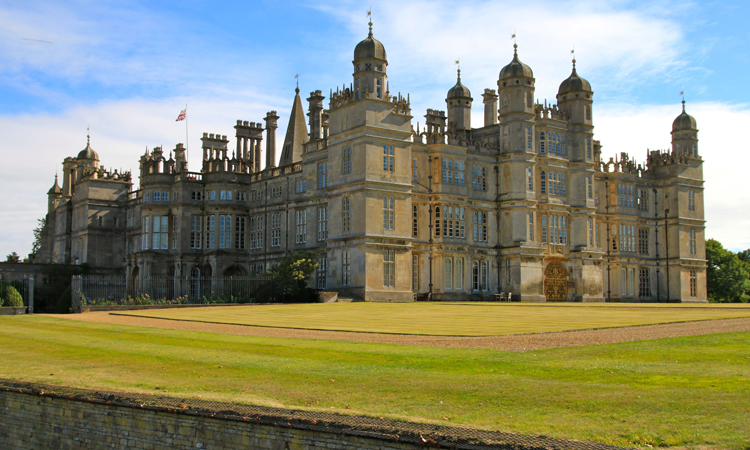To build your own Itinerary, click  to add an item to your Itinerary basket.
to add an item to your Itinerary basket.
Already saved an Itinerary?



You are here: Hudson's > Tarr on the Road > Burghley House to Castle Bytham

Image: Burghley House, photo by Nicola Burford.
11.7 miles
The morning sun was radiating from the golden stone and accentuating the grandeur of the wonder that is Burghley House. Commissioned by Queen Elizabeth I’s Treasurer, the influential William Cecil 1st Lord Burghley, the building stands majestically in 1400 acres of parkland laid out by Lancelot ‘Capability’ Brown in the 18th century. Burghley would normally be an outstanding climax to a four day heritage walk but the sumptuous interiors, works of art by Thomas Gainsborough and tapestries by John Vanderbank were delights hidden from view because the house was temporarily closed to the public. Burghley is often used as a filming location and on my arrival a small ’town’ of vans, marquees and support personnel indicated that a significant production was underway, apparently The Crown, the highly acclaimed Netflix series. I did, however, get to experience the imaginative Gardens of Surprise. A clever collection of interactive fountains and waterfalls nestled alongside a display of modern sculptures set within a wooded landscape.
So onwards to Stamford, a town rich in history, beauty and culture. Before the Norman Conquest it was one of the five boroughs of the Viking Danelaw and during the Middle Ages became prosperous through the wool trade. However, partly due to its residents’ opposition to the London to Edinburgh railway being built through the town, Stamford failed to capitalise on the opportunity of the Industrial Revolution. It remains a picturesque mix of medieval and Georgian, locked in time and, in 1967, became England’s first conservation area. Passing the 16th century George Hotel and crossing the Town Bridge, I happened upon St Mary’s Passage, an intriguing Norman alleyway believed to be a postern gate in the old town walls and typical of the nooks and crannies in Stamford.
Lunch was at The Central Café in Red Lion Square, a building is believed to be part of a 15th century wool house with associations to the merchant William Browne. He invested in a number of buildings in the town and built nearby Browne’s Hospital. Climbing the café’s stairs to the first floor I came across some remarkable ancient stained glass panels.
I left the town on the Old Great North Road which follows the course of Roman Ermine Street. By the time I arrived at Great Casterton I had left Lincolnshire and entered Rutland. My route turned north along the Rutland Round National Trail passing the remains of Woodhead Castle to the right. This moated ringwork mound, formerly a manor house, was visited by Edward I in 1290. To my left was the site of the Battle of Empingham fought in 1470 during the Wars of the Roses. This engagement, instigated by Lincolnshire rebels against Edward IV had, unknown to the king, been supported by his former ally Warwick the Kingmaker. As a result the two men were in open conflict culminating in Warwick’s demise at the Battle of Barnet in 1471.
This area has a close association with the working class 19th century romantic poet John Clare and, at the village of Pickworth, there are remains of a lime kiln where Clare once worked. It was here that I first encountered The Drift, an ancient trackway which, for a large stretch, is the border between Lincolnshire and Leicestershire. Heading towards Clipsham, I passed limestone quarries with which this part of the world is pock-marked. Canterbury Cathedral, York Minster and the Houses of Parliament are just some of the important buildings where the stone has been used. Just outside the village of Clipsham is Yew Tree Avenue, the old carriageway to the local hall. For a third of a mile 150 trees, each individually shaped, stand sentinel, a topiary marvel is now maintained by The Clipsham Yew Tree Avenue Trust.
Back into Lincolnshire, I arrived at Castle Bytham and passed the 11th century Norman castle mound as the evening sun began to set, I was greeted by a flock of waddling ducks making their way from the village pond to their own night’s rest.
© Visit Heritage 2025. All Rights Reserved

.png)


